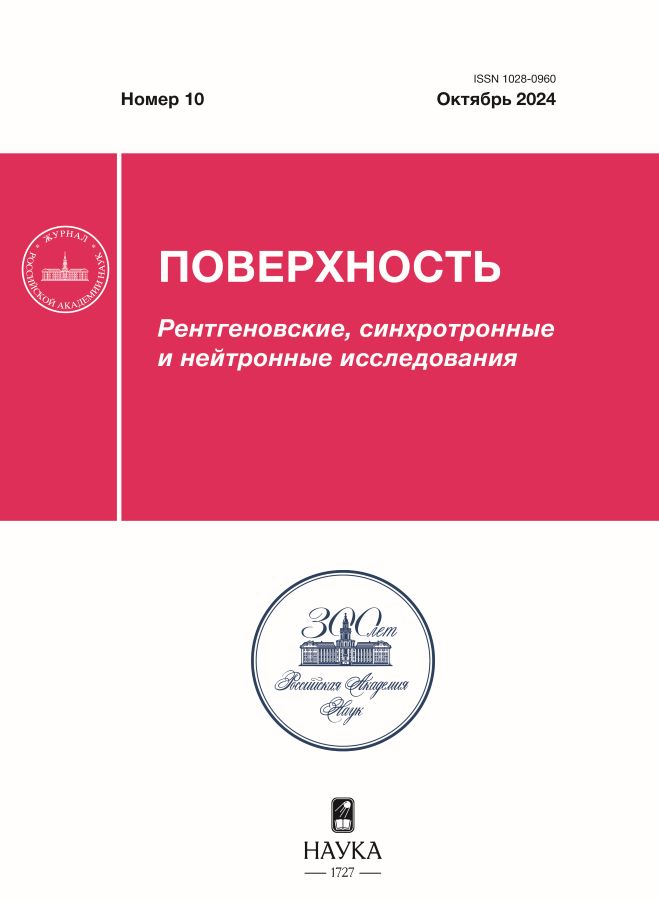Radiation-stimulated processes under interaction of ions with porous structures
- Авторлар: Nikiforova N.N.1,2, Oksengendler B.L.2,3, Ashurov K.B.1, Kutlimurotov B.R.1, Maksimov S.Е.1, Galkina О.А.3
-
Мекемелер:
- Arifov Institute of Ion Plasma and Laser Technologies, Academy of Sciences of the Republic of Uzbekistan
- Institute of Materials Science, Academy of Sciences of the Republic of Uzbekistan, Scientific and Production Association “Physics-Sun”
- Institute of Polymer Chemistry and Physics, Academy of Sciences of the Republic of Uzbekistan
- Шығарылым: № 10 (2024)
- Беттер: 80-86
- Бөлім: Articles
- URL: https://hum-ecol.ru/1028-0960/article/view/664736
- DOI: https://doi.org/10.31857/S1028096024100104
- EDN: https://elibrary.ru/SGYZCX
- ID: 664736
Дәйексөз келтіру
Аннотация
For objects with topological and fractal dimensions (using the example of a “Coulomb explosion”), the physics of modification of electron-stimulated processes in porous media under irradiation with multiply charged ions is considered. A quasi-one-dimensional model has been constructed, which is a convenient methodological approach that describes characteristic phenomena in various media. The results obtained are assessed within the framework of the “complexity” concept.
Негізгі сөздер
Толық мәтін
Авторлар туралы
N. Nikiforova
Arifov Institute of Ion Plasma and Laser Technologies, Academy of Sciences of the Republic of Uzbekistan; Institute of Materials Science, Academy of Sciences of the Republic of Uzbekistan, Scientific and Production Association “Physics-Sun”
Email: oksengendlerbl@yandex.ru
Өзбекстан, Tashkent; Tashkent
B. Oksengendler
Institute of Materials Science, Academy of Sciences of the Republic of Uzbekistan, Scientific and Production Association “Physics-Sun”; Institute of Polymer Chemistry and Physics, Academy of Sciences of the Republic of Uzbekistan
Хат алмасуға жауапты Автор.
Email: oksengendlerbl@yandex.ru
Өзбекстан, Tashkent; Tashkent
Kh. Ashurov
Arifov Institute of Ion Plasma and Laser Technologies, Academy of Sciences of the Republic of Uzbekistan
Email: oksengendlerbl@yandex.ru
Өзбекстан, Tashkent
B. Kutlimurotov
Arifov Institute of Ion Plasma and Laser Technologies, Academy of Sciences of the Republic of Uzbekistan
Email: oksengendlerbl@yandex.ru
Өзбекстан, Tashkent
S. Maksimov
Arifov Institute of Ion Plasma and Laser Technologies, Academy of Sciences of the Republic of Uzbekistan
Email: oksengendlerbl@yandex.ru
Өзбекстан, Tashkent
О. Galkina
Institute of Polymer Chemistry and Physics, Academy of Sciences of the Republic of Uzbekistan
Email: oksengendlerbl@yandex.ru
Өзбекстан, Tashkent
Әдебиет тізімі
- Oksengendler B.L., Maksimov S.E., Turaeva N.N., Djurabekova F.G. // Nucl. Instrum. Methods Phys. Res. B. 2014. V. 326. P.45. https://doi.org/10.1016/j.nimb.2013.09.040
- Максимов С.Е., Оксенгендлер Б.Л., Тураев Н.Ю. // Поверхность. Рентген., синротр. и нейтрон. исслед. 2013. № 4. С. 42. https://doi.org/10.7868/S0207352813040161
- Оксенгендлер Б.Л., Зацепин А.Ф., Аширметов А.Х., Тураева Н.Н., Сулейманов С.Х., Никифорова Н.Н., Ашуров Х.Б. // Поверхность. Рентген., синротр. и нейтрон. исслед. 2022. № 6. С. 53. https://doi.org/10.31857/S1028096022060139
- Бак П. Как работает природа. М.: УРСС, 2013. 276 с.
- Parilis E.S., Kishinevsky L.M., Turaev N.Y., Baklitzky B.E., Umarov F.F., Verleger V.Kh., Nizhnaya S.L., Bitensky I.S. Atomic Collisions on Solid Surfaces. Amsterdam: North-Holland, 1993. 664 p.
- Auger P. // Comptes Rendus de l’Académie des Sciences. 1923. V. 177. P. 169.
- Meitner L. // Z. Physik. 1922. B. 9. № 1. S. 131. https://doi.org/10.1007/BF01326962
- Парилис Э.С. Эффект Оже. Ташкент: Фан, 1969. 205 с.
- Szilard L., Chalmers C.A. // Nature. 1934. V. 134. P. 462. https://doi.org/10.1038/134462b0
- Cooper J.W. // Phys. Rev. 1962. V. 128. P. 681. https://doi.org/10.1103/PhysRev.128.681
- Platsman R.L. // Radiat. Res. 1955. V. 2. P. 1. https://doi.org/10.2307/3570224
- Varley J.A. // Nature. 1954. V. 174. P. 886. https://www.nature.com/articles/174886a0
- Dexter D.L. // Phys. Rev. 1960. V. 118. P. 934. https://doi.org/10.1103/PhysRev.118.934
- Yunusov M.S., Zaikovskaya M.A., Oksengendler B.L., Tokhirov K.R. // Phys. Stat. Sol. A. 1976. V. 35. P. 145. https://doi.org/10.1002/pssa.2210350260
- Turaeva N.N., Oksengendler B.L., Ruban I.N., Rashidova S. // Dokl. Chem. 2002. V. 387. P. 302. https://doi.org/10.1023/A:1021174422477
- Suleymanov S.X., Oksengendler B.L., Kulagina N.A. // Crystallogr. Rep. 2021. V. 66. № 6. P. 1066. https://doi.org/10.1134/S1063774521060419
- Fleischner R., Price P., Walker R. Nuclear Tracks in Solids. Berkeley: University of California Press, 1975. 605 p.
- Оксенгендлер Б.Л., Тураева Н.Н. Радиационная физика конденсированных сред. Т. 1. Ташкент: Фан, 2006. 136 с.
- Oksengendler B.L., Ashirmetov A.Kh., Turaeva N.N. et al. // Nucl. Instrum. Methods Phys. Res. B. 2022. V. 512. P. 66. https://doi.org/10.1016/j.nimb.2021.12.009
- Yokoya A., Ito T. // Int. J. Radiat. Biol. 2017. V. 93. № 8. P. 743. https://doi.org/10.1080/09553002.2017
- Gharibkandi N.A., Gieraltowska J., Wawrowicz K., Bilewicz A. // Materials. 2022. V. 15. № 3. P. 1143. https://doi.org/10.3390/ma15031143
- Anderson P.W. // Phys. Rev. 1958. V. 109. P. 1492. http://refhub.elsevier.com/S0168-583X(21)00419-5/h0255
- Тихомиров В.П., Горленко О.А., Измеров М.А. // Изв. Самарского науч. центра РАН. 2011. Т. 13. № 4(3). С. 879.
- Федер Е. Фракталы. М.: Мир, 1991. 254 с.
- Nicolis G., Prigogine I. Exploring Complexity, Аn Introduction, New York: W. H. Freeman & Company, 1989. 328 р.
- Чукбар К.В. // ЖЭТФ. 1995. Т. 108. Вып. 5 (11). С. 1875.
- Олемской А.И., Флат А.Я. // УФН. 1993. Т. 13. Вып. 12. С. 1.
Қосымша файлдар















